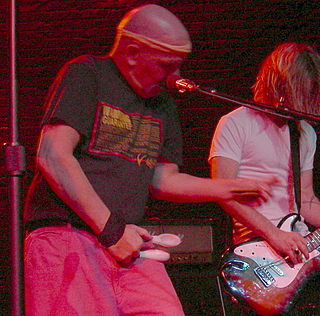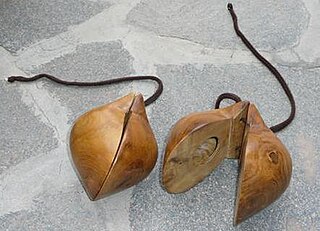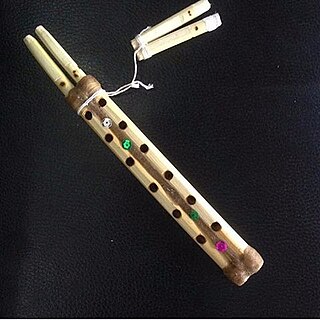
A cymbal is a common percussion instrument. Often used in pairs, cymbals consist of thin, normally round plates of various alloys. The majority of cymbals are of indefinite pitch, although small disc-shaped cymbals based on ancient designs sound a definite note. Cymbals are used in many ensembles ranging from the orchestra, percussion ensembles, jazz bands, heavy metal bands, and marching groups. Drum kits usually incorporate at least a crash, ride, or crash/ride, and a pair of hi-hat cymbals. A player of cymbals is known as a cymbalist.

A percussion instrument is a musical instrument that is sounded by being struck or scraped by a beater including attached or enclosed beaters or rattles struck, scraped or rubbed by hand or struck against another similar instrument. Excluding zoomusicological instruments and the human voice, the percussion family is believed to include the oldest musical instruments. In spite of being a very common term to designate instruments, and to relate them to their players, the percussionists, percussion is not a systematic classificatory category of instruments, as described by the scientific field of organology. It is shown below that percussion instruments may belong to the organological classes of idiophone, membranophone, aerophone and chordophone.

Zills or zils, also called finger cymbals, are small metallic cymbals used in belly dancing and similar performances. They are called sāgāt in Egypt. They are similar to Tibetan tingsha bells. In Western music, several pairs can be set in a frame to make a tambourine.

A pit orchestra is a type of orchestra that accompanies performers in musicals, operas, ballets, and other shows involving music. The term was also used for orchestras accompanying silent movies when more than a piano was used. In performances of operas and ballets, the pit orchestra is typically similar in size to a symphony orchestra, though it may contain smaller string and brass sections, depending upon the piece. Such orchestras may vary in size from approximately 30 musicians to as many as 90–100 musicians. However, because of financial, spatial, and volume concerns, current musical theatre pit orchestras are considerably smaller.

Qraqeb or garagab, in English often transliterated as krakeb, are a large iron castanet-like musical instrument primarily used as the rhythmic aspect of Gnawa music. Gnawa today is part of the North African culture and is inherent in the Maghrebi soundscape. The word qraqeb is a plural form, with an unclear etymology, as the word does not occur in Standard Arabic with this meaning.

Persian musical instruments or Iranian musical instruments can be broadly classified into three categories: classical, Western and folk. Most of Persian musical instruments spread in the former Persian Empires states all over the Middle East, Caucasus, Central Asia and through adaptation, relations, and trade, in Europe and far regions of Asia. In ancient era, the Silk Road had an effective role in this distribution.

Castanets, also known as clackers or palillos, are a percussion instrument (idiophone), used in Spanish, Calé, Moorish, Ottoman, Italian, Mexican, Sephardic, Portuguese, Brazilian and Swiss music. In ancient Greece and ancient Rome there was a similar instrument called the crotalum.

Spoons can be played as a makeshift percussion instrument, or more specifically, an idiophone related to the castanets. They are played by hitting one spoon against the other.
The dili tuiduk is a Turkmen musical instrument in the clarinet-family that uses a single reed to produce the instrument's sound. It is used mainly in Turkmen folk music.
The bock-a-da-bock is a musical instrument in the percussion family consisting of two small cymbals attached to each other by a set of metal tongs. They are typically played in a pair by one percussionist, much like the castanets. However, several other instruments of this type are also referred to as bock-a-da-bocks, such as the squash cymbal and the hand-sock cymbal.

Khartal is an ancient instrument mainly used in devotional / folk songs. It has derived its name from Sanskrit words ‘kara’ meaning hand and ‘tala’ meaning clapping. This wooden clapper is a Ghana Vadya which has discs or plates that produce a clinking sound when clapped together. It falls under the class of idiophones of self-sounding instruments that combine properties of vibrator and resonator.

Chácaras are a type of castanets from the Canary Islands. They are an idiophonic and chattering instrument, with an interior cavity. It is typically made of moral wood.
The Loh Tarang is a melodic percussion instrument. It consists of a set of iron circular plates, of different sizes, held in a frame. Each plate is pitched to a note and they are struck with sticks on each hand. 'Tarang' literally means waves. Plates sound depends on the different size of plate and hand movement. Theory is based like Jal-Tarang.

Folk dances of Assam include the Bihu and the Bagurumba, the Bhortal, the Ojapali dance. Assam is home to many groups: Muslim, Indo-Aryan, Rabha, Bodo, Dimasa, Karbi, Mising, Sonowal Kacharis, Mishmi and Tiwa (Lalung) etc. These cultures come together to create an Assamese culture. Residents of the state of Assam are known as "Axomiya" (Assamese). Most tribes have their own language, although Assamese is the primary language of the state.

There are several overlapping schemes for the classification of percussion instruments.

Pilili is a reed wind instrument in Adjara, west Georgia. It is a pipe of 25-30cm in length with 5-7 keys.

The Dozaleh is an Iranian folk instrument. The dozaleh is made of two pipes. One of them produces melody and the other harmony. It sounds like a Ney-anbān and it is very dynamic.

Zang means bell in Persian, for both large bells and small. The term has historically been applied to a number of ringing metal musical instruments, including large bells with clappers worn by elephants, smaller 3-9 inch bells worn on camels, horses, donkeys and cattle, 2-3 inch sheep bells, and tiny bells tied to the legs of hawks. It also applies to clusters of small bells worn by musicians and dancers, sewn onto cloth bracelets and anklets, or laced on a long string to be wrapped around the waist or hung as a necklace.

The bülban is a historical musical instrument from the Caucasus, Middle East and Central Asia. It was a reed pipe, with an apricot wood body and tipped with a tubular single-reed. It had 7 fingerholes and a thumbhole and played a diatonic scale from E♭1 to E♭3. By half-covering fingerholes, it could play a chromatic scale. The instrument has been documented in Azerbaijan, and one can be seen in a photo from the mid-19th-century Russian Turkestan.






















